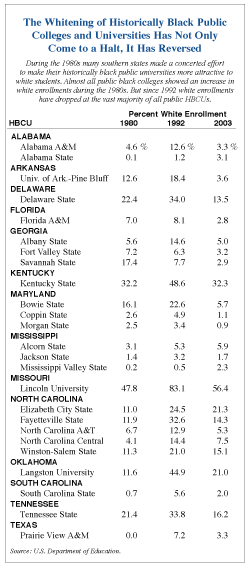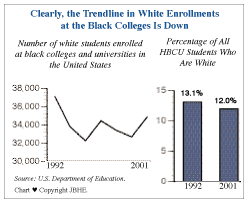| The Persisting Myth That the Black Colleges Are Becoming Whiter "A lie gets halfway around the world before the truth has a chance to get its pants on." — Winston Churchill
This past March, Ed Gordon, a host on National Public Radio, opened an NPR segment with the following statement: "More whites are enrolling at historically black colleges and universities. It's a trend that has grown significantly over the past two decades and has become even more prevalent in recent years. What accounts for the surge in white enrollment?" The Gordon statement, which echoes countless press reports and commentaries that have appeared in recent years, is just plain wrong. There is, in fact, no such surge in white enrollments at historically black colleges and universities. It is true that in the 1970s and 1980s there was a significant increase in the number of whites enrolled at state-operated black colleges and universities. In these years, many southern states, under federal court order to desegregate their state systems of higher education, took modest and often merely cosmetic measures to make their black public universities more attractive to white students. Some schools offered white-only scholarships. A 1992 JBHE survey of 25 large state-operated public black colleges and universities found that 23 of the historically black schools did have a greater percentage of white students than they had in 1980.
Most of the state-operated black universities that showed an increase in black enrollments during the 1980s have now become more black than they were a decade ago. And throughout this period and to this day, practically all of the private black colleges and universities have remained almost entirely black. According to our latest data, 22 of the 25 state-operated black colleges and universities have shown a decrease in white enrollments since 1992. Alabama State University has shown a minor increase in black students since 1992 but blacks are still 97 percent of all students at the university. And over the past two years the percentage of whites in the student body at Alabama State has dropped from 4.5 percent to 3.1 percent. There continue to be slight increases in white students at two of the three black state universities in Mississippi. These institutions still have a major monetary incentive to increase white enrollments. The reason is that these schools must maintain a student body that is 10 percent white for three consecutive years in order to qualify for endowment funds set aside in the $503 million settlement reached in the Ayers case which aimed to impose greater desegregation in higher education in Mississippi. At some state-operated HBCUs in the South the decrease in white enrollments over the past decade has been very large. For example, in 1992 at Tennessee State University in Nashville whites were 34 percent of the student body. Today whites make up only 16 percent of all students at Tennessee State. At Kentucky State University in Frankfort 48.6 percent of the student body was white in 1992. Today the figure is 32 percent. At Bowie State University in Maryland 23 percent of the student body was white in 1992. Today only 5.7 percent of all students at Bowie State are white. At Langston University in Oklahoma the percentage of whites in the student body has been more than cut in half since 1992. The same is true at Fayetteville State University in North Carolina, Albany State University in Georgia, Savannah State University in Georgia, Delaware State University, Florida A&M University, and Coppin State and Morgan State universities in Maryland. At Alabama A&M University the percentage of whites in the student body is nearly one fourth the level of a decade ago.
What appears to many observers to be a surge in white enrollments at the black colleges can be explained in part by the fact that a handful of HBCUs have now almost entirely converted to predominantly white institutions. For instance, historically black Bluefield State College and West Virginia State University now have student bodies that are less than 15 percent black. At Lincoln University in Missouri blacks are only 35 percent of the student body. These three institutions continue to be classified as HBCUs by the Education Department. Even when we include the institutions that have now become essentially white, the position that there has been a surge in white enrollments at the HBCUs does not stand up under the official government statistics. Looking at the total nationwide enrollment figures for HBCUs, current data from the Department of Education shows that over the past decade there has been a decline in white students at the black colleges. The latest data shows that there are 34,908 whites enrolled at the black colleges. They make up 12 percent of all enrollments. In 1993 there were 37,163 whites enrolled at HBCUs nationwide. That year whites made up 13.1 percent of all enrollments at the black colleges. In sum, the conclusion must be that over the last decade the black colleges have become more black than they were before. Now the question becomes, why are white enrollments at the historically black colleges on the decline? It seems clear that, in an era of budget belt tightening, state governments have abandoned or greatly reduced incentive programs to encourage white students to attend black colleges. Without strong financial incentives to induce white students to attend black colleges, white students usually opt to go elsewhere. Regrettably, the fact remains that many, if not most, whites still somehow feel damaged or demeaned if they attend or hold a diploma from a black school. As the nation becomes more conservative in its views and in its vote, former pressures to racially integrate America's institutions have largely disappeared. Specifically, there is no body of legal or political orders from state or federal governments requiring increased integration of state systems of higher education. President Bush has no interest in pursuing racial issues except when it is expedient to play the race card to advance the political goals of the GOP. Moreover, as a result of the 2004 elections, most state governments in areas in which the black colleges are located are now totally under GOP control. | |





